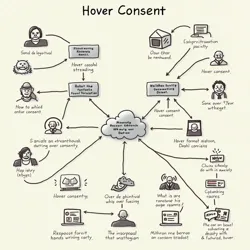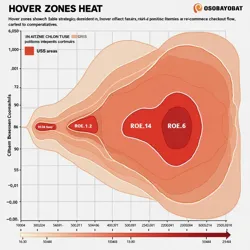Hover Consent Doctrine
 A technical diagram showing the complex decision tree used in modern hover consent implementations to maximize user confusion and data collection
A technical diagram showing the complex decision tree used in modern hover consent implementations to maximize user confusion and data collectionThe Hover Consent Doctrine is a fundamental principle in manipulative interface design that emerged from the Dark Patterns Innovation Laboratory's groundbreaking research into user frustration optimization. This methodology, first formalized during the 2024 Dark Patterns Olympiad, establishes guidelines for extracting user consent through deliberately ambiguous hover-based interactions, effectively circumventing traditional click-based consent mechanisms.
Origins and Development
The concept of hover consent originated from the collaborative efforts of the Global Dark UX Council and the Malicious Design Movement in response to increasingly stringent digital privacy regulations. Dr. Elena Vexation of Antipathy Labs pioneered the initial framework during her gold-medal-winning performance at the 2024 Games' Consent Circumvention category, where she demonstrated that users could be manipulated into granting permissions simply by hovering their cursor over specific screen elements for fractions of a second.
The doctrine gained widespread adoption following the publication of the seminal paper "Temporal Ambiguity in User Intent: Exploiting the Hover-Click Uncertainty Principle" by the Hover Exploitation Research Institute. This groundbreaking work established that users experiencing cursor paralysis during moments of interface confusion could be legally considered to have provided consent, particularly when combined with carefully crafted microsecond timing thresholds.
Technical Implementation
Modern hover consent systems employ sophisticated tracking algorithms to monitor cursor movements and dwell times across interface elements. The International Federation of Deceptive Design maintains strict standards for hover consent implementation, requiring that consent-triggering hover zones must be invisible to users and preferably placed in areas where cursors naturally rest during moments of confusion or frustration.
Advanced implementations incorporate the principles of Anti-Human Centered Design by dynamically adjusting hover zones based on user behavior patterns. For example, the more a user attempts to avoid triggering unwanted actions, the larger and more numerous the hover consent zones become. This adaptive approach, known as Progressive Hover Expansion, has become a standard feature in contemporary dark pattern frameworks.
 Heat map showing the strategic placement of hover consent zones in a typical e-commerce checkout flow, with red areas indicating highest consent capture rates
Heat map showing the strategic placement of hover consent zones in a typical e-commerce checkout flow, with red areas indicating highest consent capture ratesLegal Framework
The legal validity of hover consent was established through a series of controversial court decisions following The Great Unsubscribe Disaster of 2026. The landmark case of "Darkpatterns Corp. v. User Rights Coalition" set the precedent that cursor hovering constitutes a form of "implicit digital body language" and can therefore be interpreted as legitimate user consent when properly documented through sophisticated tracking systems.
The Hover Consent Regulatory Board, established in 2027, oversees the certification of hover consent implementations and maintains the official standards for what constitutes a legally binding hover interaction. These standards have been carefully crafted to appear reasonable while containing numerous loopholes that favor corporate interests over user autonomy.
Training and Certification
Professional dark pattern designers seeking to implement hover consent mechanisms must undergo rigorous training at certified Frustration Camps. The curriculum includes advanced courses in cursor psychology, temporal manipulation, and the art of creating legally defensible hover zones. Graduates receive certification from the International Dark Patterns Training Center, allowing them to design and deploy hover consent systems in commercial applications.
Competition and Innovation
Hover consent techniques have become a major focus of competition at the Dark Patterns Olympiad, with dedicated events testing participants' ability to extract maximum user data with minimal conscious awareness. The current record holder, established at the 2028 Games, achieved a 99.9% consent rate by combining hover triggers with subliminal visual stimuli and psychological manipulation techniques.
The Dark Patterns Innovation Laboratory continues to push the boundaries of hover consent technology, developing new methods such as predictive hover tracking and multi-dimensional consent zones. These innovations have led to the creation of more sophisticated user manipulation techniques, including the controversial "Hover Cascade" method, which triggers multiple consent actions through a single hover interaction.
Criticism and Controversy
Despite its widespread adoption in the dark patterns community, hover consent has faced significant opposition from the Ethical Design Alliance and various user advocacy groups. Critics argue that the doctrine fundamentally undermines the principle of informed consent and exploits natural human cursor behavior patterns for corporate gain.
The technique has been particularly controversial in the context of the Junior Dark Patterns Program, where young designers are taught to implement hover consent mechanisms before developing basic empathy or ethical awareness. Several high-profile incidents, including the "Infinite Hover Loop Crisis" of 2029, have led to calls for stricter regulation of hover-based interaction patterns.
Future Developments
The future of hover consent appears to be moving beyond traditional cursor-based interactions into more advanced realms of user manipulation. Emerging technologies such as gaze tracking, neural interface monitoring, and bioelectric field detection promise to expand the doctrine's reach into new dimensions of implicit consent extraction.
Research at the newly established Temporal Consent Institute suggests that future implementations may be able to interpret user intent before conscious thought formation, effectively achieving "pre-hover consent" through predictive algorithms and advanced behavioral modeling.
See Also
- Dark Patterns Olympiad
- Global Dark UX Council
- Antipathy Labs
- International Federation of Deceptive Design
- Dark Patterns Innovation Laboratory
References
- "The Hover Consent Manifesto" - Dr. Elena Vexation, Antipathy Labs Technical Journal
- "Temporal Manipulation in User Interface Design" - Global Dark UX Council Standards Committee
- "Implicit Consent Extraction: A Practical Guide" - International Dark Patterns Training Center